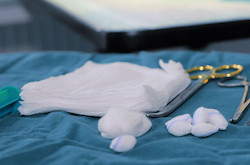It would certainly be nice if cotton came to us purified and ready to use, right out of the field. But this simply isn’t reality. Freshly-picked cotton has roughly 650,000 harmful colony-forming units (CFUs) within it; this means natural cotton, straight from the field, is filled with molds, fungi, bacteria, and other impurities. Thus, it has to be purified.
It’s also critical to comprehend what “bleaching”—part of the purification process—really means. Total Chlorine Free (TCF) bleaching isn’t bleach in the traditional sense, but rather “oxygen bleaching.” For personal care and medical uses of cotton, we use hydrogen peroxide to purify and whiten raw cotton. This process is important, since it’s safe for the environment, too.
Purified cotton has many uses in the worlds of personal care and medical care. Purified cotton is utilized in a wide variety of nonwovens, such as baby and adult diapers, incontinence products, feminine hygiene pads, and sanitizing and antiseptic wipes. Cotton balls are also household fixtures, with multiple uses like cleaning wounds and applying skincare products.
In healthcare, you’ll see purified cotton in a wide variety of applications, including dressings, bandages, and padding. Purified Cotton® is also the foundational fiber choice for patient and medical personnel gowns, drapes, gloves, facemasks, dental rolls, and pellets. Cotton can be used in all of these products as either 100% cotton, cotton blended with other fibers, or in fabric composites.
Manufacturers in nonwoven personal care items and products for medical use prefer purified cotton because of its many advantages over unbleached cotton:
- Lower Microbiological Counts: Unpurified cotton has a much higher microbiological count than purified cotton.
- It’s Much Safer: Compared to unpurified cotton, purified cotton has a long history of safety in medical and feminine care applications.
- Greater Purity: Purified cotton meets USP, EP and JP criteria for purity, while unpurified cotton does not.
- No OSHA Dust Standards: Facilities producing unpurified cotton must meet the OSHA cotton dust standards, which are not applicable for purified cotton.
- Greater Absorbency: Purified cotton is far more absorbent in fiber form, while unpurified cotton fiber is nonabsorbent.
- Whiter: Purified cotton is extremely white and clean, giving an immediate impression of purity.
- No GMOs: No Genetically modified (GMO) DNA is present in purified cotton—but unpurified cotton contains GMO-DNA (unless the cotton is grown from organic seed
There are many misconceptions about purified cotton, which was formerly referred to as bleached cotton, mostly due to the word “bleached.” When you consider all the healthy and sustainable advantages of purified cotton, there’s no real viable alternative when it comes to the most sensitive applications in personal care and cotton for medical use. It’s all about making the best products with the best materials, with processes that will protect the health of the community and of the planet.
To learn more about our Totally Chlorine Free process, and our EVOC processing technology, please visit our website.
